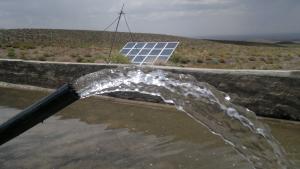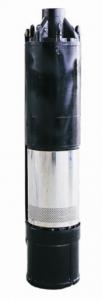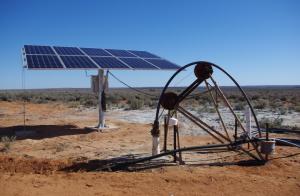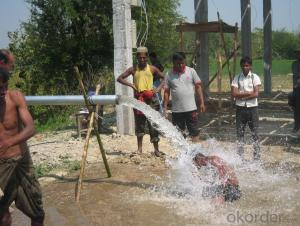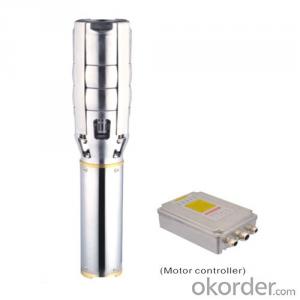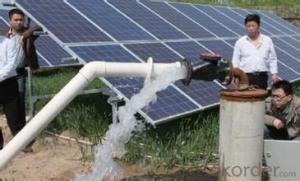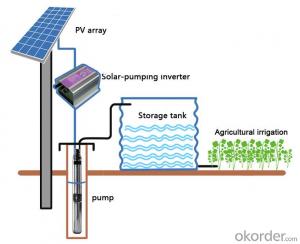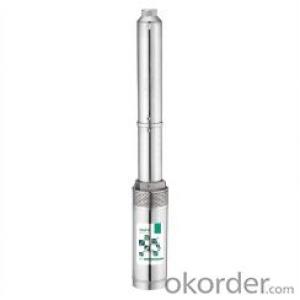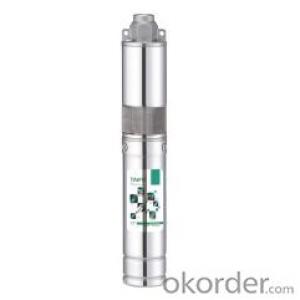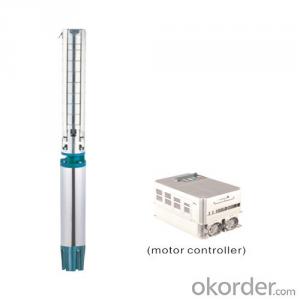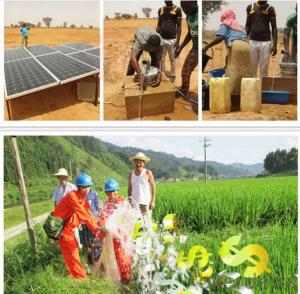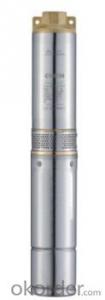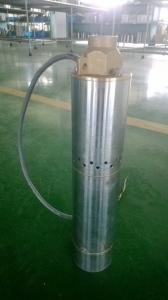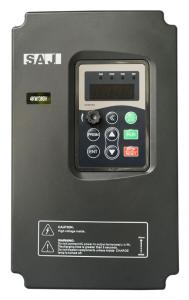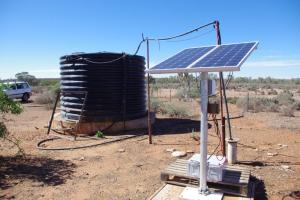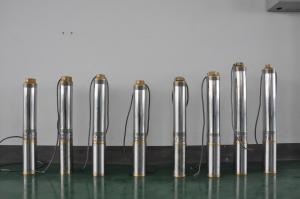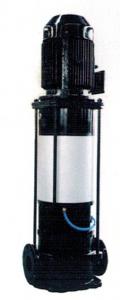4tsc Solar Pump Stainless Steel CE, Solar Panel - Solar Pump BP200
- Loading Port:
- Shanghai
- Payment Terms:
- TT OR LC
- Min Order Qty:
- 50 pc
- Supply Capability:
- 100000 pc/month
OKorder Service Pledge
OKorder Financial Service
You Might Also Like
1.APPLICATION AREA:This project products are mainly used in dry region for irrigation of agriculture, It can be used for drinking water and
living water. The living condition could be much improved. It also can be used for fountains.2.MATERIAL OF PARTS:Outlet: stainless steel
Pump body: stainless steel
Motor body: stainless steel
Bearing: C&U
3.ADVANCED TECHNOLOGY:1.Application innovation
Compared with the traditional alternating current machine, the efficiency is improved 25% by the permanent magnetism, direct current, brushless, non-sensor motor.
2.Technics innovation
Adopt double plastic package for rotor and stator, motor insulation≥300MΩ, the motor security was much improved.
3.Structure innovation
Oil filling, convenient installation and environmental protection4.HIGHLIGHTSa.Energy-saving and environment-protected green products
b.High technique products adopting MPPT and DSP chip technique.
c.100% copper wire, cold-rolled silicon steel sheet
d.CE certificate
e.Advanced three phase brushless DC motor
f.Stainless steel 316 screws
g.3 years warranty5.PRINCIPLE OF OPERATION:Solar panel collects sunlight→DC electricity energy → solar controller(rectification,stabilization,amplification,filtering)→available DC electricity→(charge the batteries)→pumping water6.ADVANTAGES OF SOLAR PUMP SYSTEM:A.It is easier and more widely used than any other dynamoelectric driven pumps.
B.It is more economical and more environmentally friendly.7.MODEL SELECTION:a.The power of solar panel = power of pump ×1.3
The voltage of solar panel = the voltage of pump
The controller should be matched
b.Select the batteries according to the following formulas:
The use hour of battery =
The battery capacity ÷(the machine power÷the battery voltage)×0.6 For example,the machine power is 200W, the battery
capacity is 100AH,the voltage is 12V,and the battery is fully charged,then the use hour is:100÷(200÷12)×0.6=3.6hours
c.The battery capacity=
the use hour ÷0.6×(the machine power÷the battery voltage) For example,the machine power is 200W,the battery voltage
is 12V,and the battery need to be used for 3.6hours,then the battery capacity is:3.6÷0.6×(200÷12)=100AH
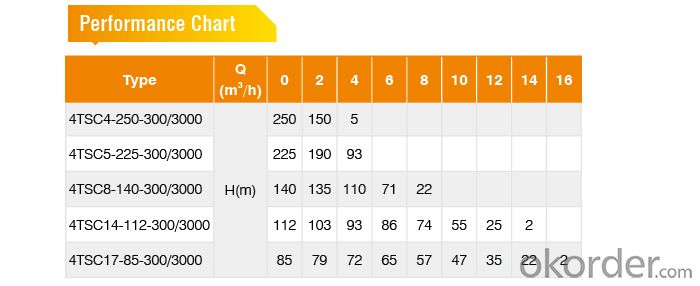

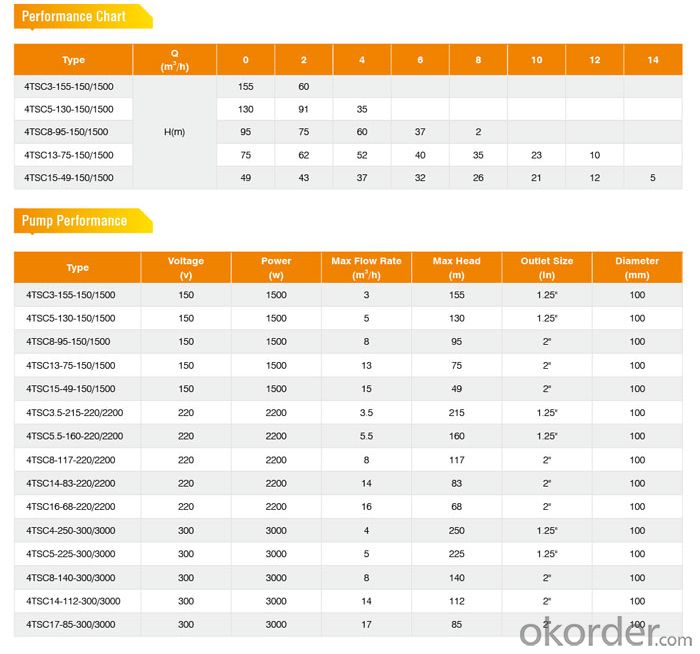
- Q: How does a solar pump handle water source contamination from mining activities?
- A solar pump itself does not directly handle water source contamination from mining activities. However, it can be used as a tool to access alternative water sources that are not affected by mining activities. By utilizing a solar pump, clean water from underground sources or nearby rivers can be extracted and used instead, mitigating the risk of contamination from mining activities.
- Q: Can a solar pump be used for water supply in wildlife sanctuaries or conservation areas?
- Yes, a solar pump can be used for water supply in wildlife sanctuaries or conservation areas. Solar pumps are a sustainable and eco-friendly alternative to traditional pumps that rely on fossil fuels or electricity from the grid. They harness solar energy to power the pump, allowing for a constant and reliable water supply without harming the environment or disrupting the natural habitat of the wildlife. Solar pumps can be installed in remote or off-grid areas, making them ideal for wildlife sanctuaries or conservation areas that may not have access to traditional sources of electricity. Additionally, solar pumps require minimal maintenance and have a long lifespan, making them a cost-effective and efficient solution for providing water to wildlife in these protected areas.
- Q: Can solar pumps be used in conjunction with other renewable energy sources?
- Yes, solar pumps can be used in conjunction with other renewable energy sources. Solar pumps are typically powered by solar panels, which convert sunlight into electricity. However, it is possible to combine them with other renewable energy sources like wind turbines or hydroelectric systems. This way, the pumps can still operate during cloudy days or when there is less sunlight available, ensuring a reliable and continuous water supply.
- Q: Can a solar pump be used in areas with high wind speeds?
- Yes, a solar pump can be used in areas with high wind speeds. However, it is important to ensure that the solar pump is properly secured and protected from the strong winds to prevent any damage or malfunction. Additionally, it is advisable to choose a solar pump model that is specifically designed to withstand high wind speeds and has appropriate wind load ratings.
- Q: Can a solar pump be used in areas with high air pollution levels?
- Yes, a solar pump can be used in areas with high air pollution levels. Solar pumps rely on sunlight to generate electricity, and they are not affected by air pollution as long as sunlight can reach the solar panels. However, it is important to regularly clean the solar panels to ensure maximum efficiency, as air pollution can accumulate on the panels and reduce their effectiveness. Additionally, it is recommended to use high-quality solar panels with anti-reflective coatings to minimize the impact of air pollution on the system's performance. Overall, while air pollution may have some indirect effects on the maintenance and efficiency of a solar pump, it does not prevent its usage in areas with high pollution levels.
- Q: Can solar pumps be used for water supply in remote manufacturing or industrial sites?
- Yes, solar pumps can be used for water supply in remote manufacturing or industrial sites. Solar pumps are a reliable and sustainable solution for water supply as they operate using solar energy, eliminating the need for grid electricity or fuel. They can be installed in remote locations where access to traditional power sources is limited, providing a consistent and cost-effective water supply for manufacturing or industrial operations. Additionally, solar pumps have low maintenance requirements and can be easily integrated into existing water systems, making them an ideal choice for remote sites.
- Q: What is the lifespan of the solar panels used in a solar pump?
- The lifespan of solar panels used in a solar pump can vary, but on average, they can last anywhere from 25 to 30 years. However, with proper maintenance and care, some panels have been known to last even longer.
- Q: How does a solar pump help in reducing reliance on grid electricity?
- A solar pump reduces reliance on grid electricity by utilizing solar energy to power the pump, eliminating the need for electricity from the grid. This not only reduces the overall electricity consumption but also decreases the reliance on fossil fuel-based power sources, leading to a more sustainable and environmentally friendly solution.
- Q: Can a solar pump be integrated with other renewable energy sources like wind turbines?
- Yes, a solar pump can be integrated with other renewable energy sources like wind turbines. This integration is known as hybrid renewable energy systems and it allows for increased efficiency and reliability of power generation. By combining the intermittent nature of wind power with the consistent power generation of solar energy, a hybrid system can provide a more stable and reliable power supply for the solar pump. The integration of a solar pump and wind turbine can be achieved through a hybrid controller or an inverter that manages the power flow between the two sources. This controller ensures that the power generated by each source is efficiently utilized and stored, if required, in a battery bank for later use. During periods of low sunlight, the wind turbine can supplement the power needs of the solar pump, ensuring continuous operation. Similarly, when there is insufficient wind, the solar panels can compensate by providing the necessary power. This hybrid approach maximizes the use of available renewable energy resources, reducing reliance on non-renewable energy sources and enhancing the overall sustainability of the system. Furthermore, integrating a solar pump with a wind turbine can also help in overcoming the limitations of each energy source individually. For instance, wind power is generally more abundant at night, while solar power is at its peak during the day. By combining these two sources, the system can provide a more balanced and consistent power supply throughout the day and night. Overall, integrating a solar pump with other renewable energy sources like wind turbines offers significant benefits in terms of increased power generation, improved reliability, and enhanced sustainability. This hybrid approach allows for a more efficient utilization of available resources and contributes to the overall transition towards a cleaner and greener energy future.
- Q: Can solar pumps work at night or on cloudy days?
- No, solar pumps rely on sunlight to generate power, so they do not work at night or on cloudy days when there is limited or no sunlight available.
Send your message to us
4tsc Solar Pump Stainless Steel CE, Solar Panel - Solar Pump BP200
- Loading Port:
- Shanghai
- Payment Terms:
- TT OR LC
- Min Order Qty:
- 50 pc
- Supply Capability:
- 100000 pc/month
OKorder Service Pledge
OKorder Financial Service
Similar products
Hot products
Hot Searches
Related keywords





